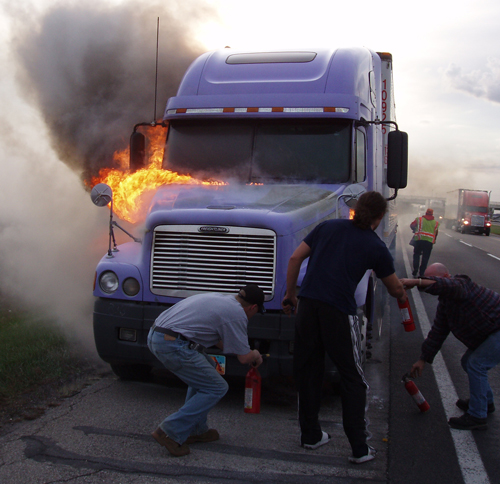Case Study: Propagation Time
Freightliner Non-collision Fire
An investigator encountered a fire in a Freightliner tractor by the side of a highway. He documented the propagation until the fire department arrived and extinguished it. [1]
The truck driver reported that the engine ran roughly, stalled, and came to a stop on an eastbound road. The driver observed fire in the engine compartment and attempted to extinguish it with a 5-pound fire extinguisher. The investigator arrived about 3 minutes later and began to photograph the fire. He reported the following events:
The first photo was taken at approximately 6:10 PM and note that there was a strong constant wind (estimated at 15 to 20 mph) from the northeast. The greatest concentration of fire was on the lower left side of the diesel engine (also confirmed by the truck driver) where the engine's fuel system components and piping are located. Cause of the fire was not known by the truck driver.

Fire was observed in the engine compartment. Wind directed propagation rearward and to the curb-side. [1]
Subsequent digital still and video photography was sequential starting from 6:10 PM and concluded at approximately 6:40 PM after fire department had extinguished most of the tractor fire and was concentrating on the enclosed aluminum refrigerated trailer containing frozen potatoes.

The progression of the fire was documented. [1]
There were several truck drivers who came to the aid of this fire with their respective dry chemical extinguishers that they carried on their semi-tractors. From approximately 6:12 PM to approximately 6:16 PM there were four dry chemical extinguishers applied to the engine compartment through various openings around the hood but to no avail. Intense heat in the engine compartment proved the extinguishing agent from various extinguishers ineffective. There were two 8 lbs. and two 5 lbs. the extinguishers used.During the fire growth stage and after consuming most of the fiberglass cab of the tractor, this investigator heard approximately five mild explosions within the engine compartment and under the cab. Although none of the mild explosions caused shrapnel to travel beyond two foot from the tractor, one explosion near the left saddle tank lifted the tractor several inches.
During this same period, this investigator heard a "pressure release sound" from the front engine compartment area; most likely was from the air-conditioning system; this investigator could not determine if there was a corresponding intensity of the fire due to the strong wind.
First Mongo Fire Department quick response fire unit arrived on scene at approximately 6:28 PM and within two minutes began applying foam solution through a single 1 ½” handline on the tractor. Mongo tanker with two firefighters arrived on scene two minutes later and supplied water to the attack unit. Fire had involved the semi-trailer before the arrival of the fire department,
A video clip of the still photographs was produced. The progression shows propagation being forced rearward more than would otherwise be expected. At times during the fire wind direction shifted, as evident by the smoke. Fire propagated forward as well, in spite of the wind. The tractor fiberglass body panels became heavily involved, as did burning material on the ground.
References